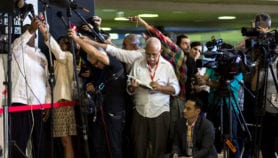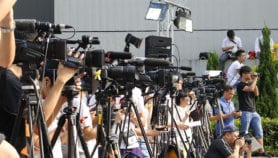Send to a friend
The details you provide on this page will not be used to send unsolicited email, and will not be sold to a 3rd party. See privacy policy.
China’s science popularisation law gives teeth to those fighting ‘pseudoscience’ — but also feeds the furore over what the term really means, report Jia Hepeng and Li Jiao.
The term ‘pseudoscience’ — unscientific theories that claim to be scientific — reliably stirs up overheated debate within China’s science community, and even amongst the general public, whenever it comes into the media spotlight.
One side argues that the term has been abused as a weapon to attack innovation. The other — those who would call themselves true scientists — claims those are the words of pseudoscientists.
Since late November, a debate on whether to remove the term from China’s science popularisation law has spread from websites and newspapers to television.
In one televised debate, quarrels between the furious participants erupted into a physical fight, which had to be halted by staff.
“So many issues — such as so-called mistreated non-professional scientists, traditional knowledge and scientific misconducts — are involved,” says Lei Yihong, deputy director of the China Research Institute for Science Popularization. “There is always something to reignite the debate.”
It has called the country to question the nature of science and who should define what is — and is not — scientific.
Opening words
The debate began in November 2006 with an open letter by Song Zhenghai, a retired research fellow of the Institute for the History of Natural Science of Chinese Academy of Sciences. Song called for the term ‘pseudoscience’ to be removed from the 2003 science popularisation law, which states that science communicators are responsible for exposing pseudoscience.
Media attention was drawn to the letter when Fang Shimin — branded the head of the ‘science police’ for his persistent exposure of scientific misconduct — lost a libel lawsuit (see Critic of scientific fraud in China loses libel case ). A science columnist with a biochemistry PhD from the US-based Michigan State University, Fang airs his views and highlights examples of pseudoscience on the Chinese website New Threads.
On 21 November 2006, the Beijing Intermediary Court ruled that Fang had libelled Liu Zihua, an ex-government consultant in Sichuan who died in 1992.
In the 1930s, Liu claimed to have used the Eight Diagrams theory — an aspect of ancient Chinese philosophy known as Bagua — to discover a 10th planet in our solar system. Last year, the achievement was lauded as a great scientific achievement by a local newspaper in Liu’s hometown in Sichuan province.
Fang, however, said the discovery was pseudoscience — a claim disputed by Liu’s wife and sons, who took Fang to court.
| Fang Shimin |
The court ruled that he had defamed Liu. Fang was asked to apologise publicly and pay Liu’s family US$2500 compensation. Fang appealed but so far no further hearing has been held.
Before the ruling, 150 mostly retired senior scientists and engineers had written in support of Song’s letter, backing his call for the term ‘pseudoscience’ to be removed from the law. But it was only after the ruling on Fang that their efforts were noted.
“The term pseudoscience has been abused by Fang and others to strike the innovative sciences and inventions based on traditional cultures such as Eight Diagrams. Fang’s lawsuit loss shows that many of his attacks were wrong,” Song told SciDev.Net.
Unjust war?
Song and his supporters listed several ‘innovations’ that they say have been handled unjustly in the name of fighting pseudoscience.
One of these is a ‘holographic biology’ theory invented by Zhang Yingqing, during his time at Shandong University from the late 1980s to the 1990s. This suggests that parts of an organism — such as the leaf of a tree or a human hand — mirror an organism’s overall structure. It says that by looking at parts of an organism the health of the whole can be inferred.
At the time, Zhang’s theory found popularity amongst the general public, but was rejected by the biology community and labelled pseudoscience in the late 1990s. This led Zhang to lose his teaching position and research funding. He died in 2004.
Zhang and other ‘mistreated scientists’ listed by Song have not published their theories in any professional academic journal. But Song says that the refusal of the Chinese science community to accept these theories shows their narrow mindedness and conservative attitude.
“If the Chinese science authorities simply deny theories which they do not know, how can science make significant progress in China?” he argues.
This view is echoed by Ren Zhenqiu, a retired researcher at the China Meteorology Administration, who says that natural science has entered a deadlock and needs to be supplemented by knowledge from the social sciences.
Ren denies that science should be based solely on repeatable experiments and advocates the use of traditionally accepted dogmas, particularly the Eight Diagrams theory — theories that cannot be tested by experiment. According to Ren, some Chinese scientists stick too closely to their scientific dogmas to tolerate any real innovation.
But those scientists have hit back. Zhao Nanyuan, a professor at Tsinghua University who supported Fang’s accusations, says no matter how innovative a theory is it must abide by the proven findings of accepted scientific disciplines.
Zhao says the scepticism of the scientific community is not because they are too conservative, but because the theories involved cannot offer persuasive evidence, testable by experiment.
He Zuoxiu, a physicist and member of the Chinese Academy of Sciences, says encouraging innovation does not mean acknowledging every theory.
“Many of those looking to abolish the term ‘pseudoscience’ are themselves pseudoscience practitioners,” He told the Beijing Morning Post.
He says that because of widespread superstition in Chinese society, the public is easily misguided by false scientific theories.
Tradition under fire
The role of traditional knowledge has been another focus of the ongoing debate.
In October an open letter by Zhang Gongyao, professor of the philosophy of science at the Changsha-based Central South University, called for traditional Chinese medicine (TCM) to be banned from the medical care funded and provided by the state.
 |
| Is traditional Chinese medicine pseudoscience? |
| Credit: IRD |
In the letter Zhang says that TCM has too many unscientific components, high toxicity and uncertain therapeutic effects. He suggested that TCM be excluded from China’s official medical system — which would mean it could not be practised or researched in hospitals. But it could still be made available elsewhere.
Zhang’s idea was furiously opposed by TCM practitioners and rejected by the Chinese government. But Fang and He say although TCM is valuable, as proven by patients’ clinical experiences, its theories — based on the concept of Yin and Yang (darkness and brightness) and the overcoming of five forces (metal, tree, water, fire and soil) — are unscientific.
This has provoked attacks by Song and his supporters. They say scientists like Zhang are trying to eradicate Chinese traditional culture.
“If TCM is a pseudoscience, how could we Chinese people have lived thousands of years with it?” says Song.
Xu Daoyi, a retired researcher at China Seismology Administration, agrees. Xu claims he can predict earthquakes by combining the Eight Diagrams theory with modern science.
In an online discussion hosted by a popular Chinese news portal in December 2006, Xu said that throughout his career he has felt that “modern science is not enough in fields like earthquake prediction,” but that He, Fang and their colleagues have “arbitrarily refused” any ideas not established by modern science.
Fang responded that it is not his intention to eradicate Chinese traditional culture.
“Culture and science are two different things, but when you are talking about how scientific a traditional culture-originated theory is, you have to pass the test of modern science. Apparently, TCM is not up to this standard,” said Fang.
Cooling tempers
After several rounds of open arguments, the debate on pseudoscience appears to be cooling.
It seems unlikely that Song and his supporters will achieve their goal and have the term removed from law. Lei Yihong says there are no plans to make any legal revision to the science popularisation law.
Zhao Nanyuan complains that strong public interest in topics like TCM and scientific innovation has allowed internet and television media to manipulate the debate.
But some believe that the debate stirred the public interest because of science’s high status in Chinese society and ideology.
Wang Qi, a PhD fellow at the China University of Politics and Law, told a seminar at the Jiusan Society in Beijing in January that the legal stipulation of ‘fighting pseudoscience’ was a reflection of the high status of science supported by government force.
But he added, “Sometimes the involvement of political power in the science community through the forms of legislation may harm the ability of the community itself to exclude false actions and misconducts.”
Xiao Xianjing, an associate professor of philosophy of science at the Graduate University of the Chinese Academy of Science, agrees. “If someone is labelled a pseudoscientist, he or she would feel they were being seriously injured. This has led to the vehement rejection of the term.”
“Science should be a means to rationally equip the public, instead of a judge of all human knowledge and life,” he added.













